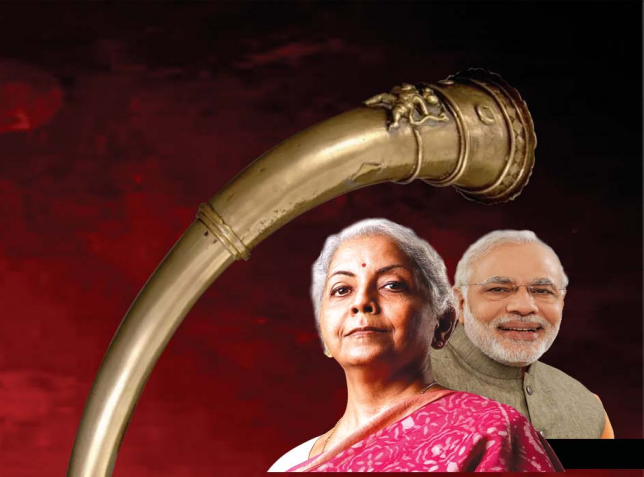Want to Subscribe?
Read Corporate India and add to your Business Intelligence

![]() Unlock Unlimited Access
Unlock Unlimited Access

Editorial
Three cheers for Union Finance Minister Nirmala Sitharaman! Even if her underlying motivation was linked to the forthcoming Lok Sabha elections early next year, she has presented a budget which is economically strong, fiscally responsible, provides relief to inflation-hit middle-class tax payers and is designed to push growth through mammoth infrastructure capex. In fact, of Ms Sitharaman’s five full-fledged budgets so far, this is her best fiscal exercise. But for the alleged scamster Gautam Adani who upset market sentiment on the eve of the budget’s presentation, this budget would have generated a rosy environment in the stock market with leading indices to new high levels.
The most important aspect of the budget is the mammoth Rs 10 lakh crore capital expenditure for infrastructure development. This measure will not only give a big boost to several related industries, including steel and cement, but will generate sizeable job opportunities.
Post-Covid, anticipated fears of a recession in the US and European economies have created a serious situation and there in an urgent need to give a big push to the Indian economy. At a time when capital formation in the private sector has slowed down, there was an urgent need for the government to pick up the growth baton and create an environment which could induce the private sector to follow the public sector and undertake capex expansion programmes. The global economic scenario is so fragile that India has emerged as the fastest growing economy in the world, even though our growth rate is negligible, relatively speaking.
Again, it is to the Finance Minister’s credit that though she has presented the budget keeping in view the forthcoming general elections, she has refrained from playing to the gallery.
The FM has distinguished between the new tax (NTR) and the old tax regime (OTR) by maintaining that the government exchequer is losing Rs 35,000 crore by promoting the NTR, under which tax concessions have been announced and tax slabs have been changed to create the impression that tax payers under the NTR will be better off financially and that the government’s loss is the gain of tax payers. But this is misleading. The net benefit to tax payers will be less than initially thought, considering the removal of various tax exemption schemes in the NTR. So, while the Finance Minister said she had foregone revenue of Rs 35,000 crore, percentage growth in income-tax revenue next year would likely be the same as in the previous year.
However, credit goes to Ms Sitharaman in this budget for her successful tight-rope walk in pegging the fiscal deficit for 2023-24 despite increased government spending. This has been rightly described as a ‘dexterous’ fiscal path caused by lower allocations for subsidies and rural jobs schemes.
A sharp 28 per cent reduction in subsidy allocation in 2023-24, compared with the revised estimates for fiscal 2022-23, and a lower outlay on schemes such as the National Rural Employment Generation Scheme, can explain the math behind the budget’s headline numbers. Besides cutting fiscal deficit, the Finance Minister has kept the public borrowing programme in check. This should keep the government’s fiscal deficit under control and leave room for future borrowings at hopefully lower interest rates than would have been the case otherwise. All of this should fuel private investment as well as consumption and help sustain the country’s economic growth rate. Additionally, if the tax revenues end up being more buoyant than budget estimates because of a thriving economy, this welcome development should be used to cut the fiscal deficit even further.
Cover story

In the last full-fledged union budget of the Modi government before the 2024 general elections, Finance Minister Nirmala Sitharaman has, as the saying goes, endeavoured to kill several birds with one stone. In her well-thoughtout budgetary exercise, she seems to have succeeded in gaining the attention of the middle class, the backbone of her Bharatiya Janata Party, with an eye on the forthcoming Lok Sabha elections next year. At the same time, she has taken steps to bolster the Prime Minister’s vision of ‘Make in India’ and ‘Atmanirbhar (self reliant) Bharat’.
Special Report
Awareness of sustainability and circularity issues, increase in yield and the need for change in the cotton industry, is currently the main focus of the Government of India. A number of initiatives are in being taken in addressing the most pressing social and environmental challenges of cotton farmers, among them demonstration of best farm practices for doubling farmers’ income along with developing transparency standards in procurement and sale of cotton.
Fortune Scrip
Several readers have requested us to select a small- priced stock which can emerge as the Fortune Scrip going ahead. Fundamentally strong and established companies can easily be selected as the Fortune Scrip but they are quoted at a very high price and hence the scope for a further rise is always limited, even though they are sound investment avenues. However, to select a Fortune Scrip right from the beginning is a hazardous exercise, as we found out.

February 15, 2025 - First Issue

Industry Review

Want to Subscribe?
Read Corporate India and add to your Business Intelligence

![]() Unlock Unlimited Access
Unlock Unlimited Access
Lighter Vein

Popular Stories
Archives
